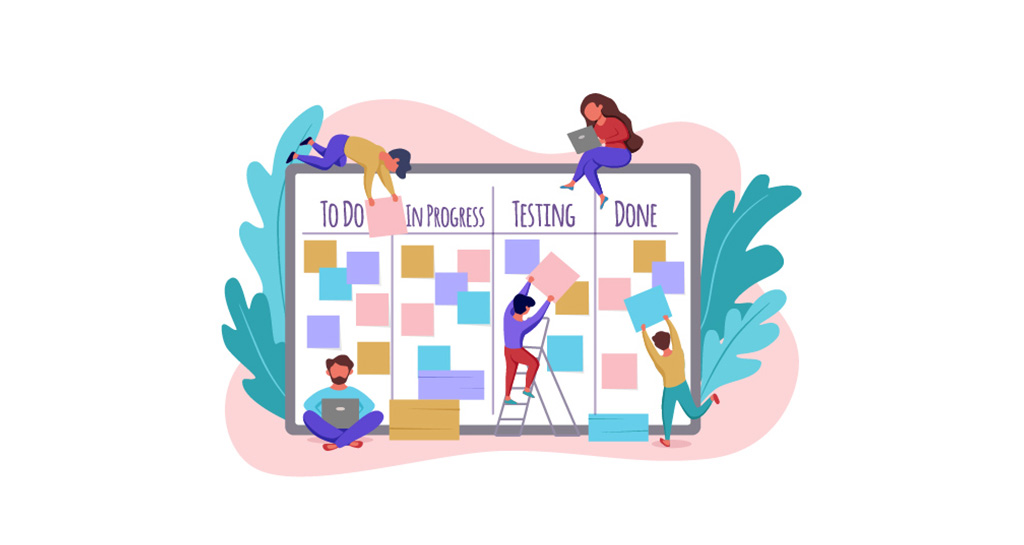
Your project management methodology is a blueprint for how you may successfully see a project from start to completion. No matter the industry or project type, everyone wants the same result from their methodology: delivering a high-quality product without wasting resources, blowing past deadlines or burning out talent. Risk avoidance is also a top priority for teams who prefer to drive forward without constantly looking for derailments.
Most teams or agencies have a preferred development or project management methodology for driving efficiency. Currently, the two most prevalent systems in use are Agile and Waterfall. In the Waterfall methodology, teams work linearly, whereas the Agile method is more cyclical in execution. Teams using an Agile method have more opportunities to revert to earlier steps if necessary and may work on multiple tasks concurrently.
With 90% of companies reporting using some Agile method such as Scrum or Kanban, it might seem like Agile methodologies are pulling ahead. Of course, the process you choose should be based on the needs of your project — not what’s popular with other organizations.
Even when you understand your project’s requirements, selecting the right method can be challenging. Organizations that take the time to employ specialized project management methodologies to suit each project have been shown to outpace those who take a one-size-fits-all approach. PMI’s 2021 “Pulse of the Profession” reported that gymnastic organizations — those who use the best possible method to address challenges — saw only 9% of investment wasted due to poor project performance. This is compared to 10.5% waste seen within traditional enterprises who only employed methods that had been effective in the past.
The “gymnastic” approach clearly has the results to back it up. But how are you supposed to choose the right methodology for specific projects? Below, I’ll break down the project features that make each one a good fit for either an Agile or Waterfall methodology.
Projects That Work Best With Agile
“Agile” has become a buzzword over the years, meaning its true meaning has been slightly distorted. To be agile doesn’t mean that you do whatever you want, however you want to do it. Agile is an iterative development approach where you continue to build based on inspection and feedback of what has already been built. The big idea behind Agile is that you simply cannot know everything at the start. You learn just enough to start building — and delivering — to test and then adapt.
Projects that succeed with Agile are very goal-centric. The team must have strong alignment around users’ problems and needs, and must have established a long-term vision and the product capabilities that might support the achievement of those goals. In rapidly changing markets where there is an extreme need for speed, Agile is the best approach.
The most popular Agile method, Scrum, is characterized by its cadence of sprint cycles — short bursts of work in which teams plan, deliver and review only a small portion of the project during a one- to four-week period. As a result of those cadences, your team is constantly and consistently delivering value to your users. Perhaps somewhat contradictorily, Scrum, like most Agile methods, assumes that actual delivery dates are very flexible. In general, Agile methods require a higher degree of user involvement and commitment to be successful. The result is generally a higher degree of project success than Waterfall, meaning you can aim for more than simply delivering on time and within budget.
Projects That Work Best With Waterfall
In Waterfall, the team has completed every exercise in the development step before moving on to the next — effectively, the entirety pours over from one to the next. As a result, you do not start to build anything until you know everything.
Projects that succeed with Waterfall are very process- and activity-centric. Applying this method assumes that development needs to occur sequentially, completing phases before continuing to the next. User involvement is only high at the start when they are gathering requirements, and at the very end when the entire product is complete.
If your organization is focused on planned versus actual delivery as a measure of value, you may find you have no choice but to use Waterfall. But other factors make it a good option as well. If you have the luxury of time and the constraints, like firm deadlines and dependencies, are well understood, Waterfall is probably your best bet. It’s also a good method if you require a high-quality, fully featured output, or if you typically work on standardized and easily repeatable projects. Lastly, it’s a safe option when the work is substantially driven by policy and compliance.
Employ the Right Methodology To Tackle Business Uncertainty
Our largest enterprise clients have many teams within their organizations, and IT/Ops generally has a much higher rate of Agile adoption than marketing and sales. Further, many organizations have systems of record that can only be changed intentionally and systematically to avoid business disruptions.
Technology typically works predictably. But how people use technology is much less certain. Gartner — one of the world’s top IT research and consultancy firms — states that organizations need to become “bimodal” in order to tackle this uncertainty. This means they’re able to manage separate but coherent methods of work, where one is focused on predictability and the other on exploration.
Many organizations feel they are eliminating risk by knowing and deciding everything up front. This locked-in approach, however, can create risk further down the line when — not if — things change. There is an economic advantage to deferring some decisions. If you are leaning toward Agile, consider the following as you shape your delivery method:
- Build strategic partnerships with system owners that are operating in Waterfall to learn their milestones and governance, and get a grasp on what is strictly unchangeable.
- Consider your own body of work to determine which decisions you need to make now — or which ones pose the highest risk — and complete those first.
- Look ahead to identify the smallest tasks you can perform between the Waterfall stream’s milestones, so you can continually prioritize and stay on plan.
- Build solid communication and feedback loops between your Agile and their Waterfall streams.
Hybrid Agile Methods
Of course, it’s up to you to decide how you’re going to adopt and implement your methodology. There is no Agile “shoulder angel” to watch your team’s every move and make sure they’re doing everything by the book. Many teams have adopted a hybrid Agile approach, which gives them the flexibility to do what works and toss out what doesn’t.
Of the marketing teams using an Agile method, AgileSherpas’ 2022 State of Agile Marketing reported that 61% use a hybrid or “Scrumban” method. Almost half of those said this was because they tried a traditional Agile method and adapted it based on what worked and what didn’t. Still, it’s important to learn the rules before you break them. I recommend learning the “classics” before adopting a hybrid method. The Scrum method has been in practice for over 20 years and is well-documented in the Scrum Guide. There are also many courses and certifications available, so there’s no shortage of materials to learn from.
You may encounter teams that claim to have adopted Scrum. Under the covers, however, you’ll often find that it’s Waterfall with a veneer of Agile or Scrum. Scrum practitioners less fondly refer to these applications as “Wagile,” “Zombie Scrum” or “cargo cult Agile.” To truly derive value from Scrum, you must change your mindset and be more willing to try things, test things and even fail.
Where We’re Headed Next
Across BDO Digital, and especially within the Demand Generation Group, we’re making a shift from purely Waterfall delivery to Agile methods where it makes sense. Our clients select our services because of our experience in complex and goal-centric digital transformation projects. We expect change along the way, and Agile gives us a strong framework in which to adapt as we learn more about the tools, culture and governance within our client organizations. Since many of our clients are also transitioning or have already transitioned their methods, this shift also drives better alignment and expectation setting. Learn more about how we are delivering value to our clients with more speed — without sacrificing quality.

Gaea Connary serves as Manager of Agile Transformation at BDO Digital. She is continually fascinated by creativity and agility in developing marketing technology, and has helped many organizations revitalize their marketing efforts with hands-on guidance and innovative tech applications.
The post Unlocking the Secret to Project Success: Flexing Between Agile and Waterfall Methodologies appeared first on DemandGen.
About the Author
More Content by DemandGen























